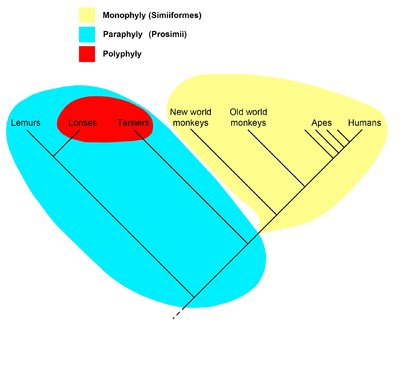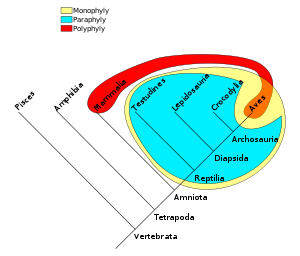Monophyly



In common cladistic usage, a monophyletic group is a taxon (group of organisms) which forms a clade, meaning that it consists of an ancestral species and all its descendants. The term is synonymous with the uncommon term holophyly. Monophyletic groups are typically characterized by shared derived characteristics (synapomorphies).
Monophyly is contrasted with paraphyly and polyphyly, as shown in the second diagram. A paraphyletic group consists of all of the descendants of a common ancestor minus one or more monophyletic groups. Thus, a paraphyletic group is 'nearly' monophyletic (hence the prefix 'para', meaning 'near' or 'alongside'.) A polyphyletic group is characterized by convergent features or habits (for example, night-active primates, fruit trees, aquatic insects); the features by which the group is differentiated from others are not inherited from a common ancestor.
These definitions have taken some time to be accepted. When the cladistic school of thought became mainstream in the 1960s, several alternative definitions were in use. Indeed, taxonomists sometimes used terms without defining them, leading to confusion in the early literature,[1] a confusion which persists.[2]
Definitions
On the broadest scale, definitions fall into two groups.
- Willi Hennig (1966:148) defined monophyly as groups based on synapomorphy (in contrast to paraphyletic groups, based on symplesiomorphy, and polyphyletic groups, based on convergence). Some authors have sought to define monophyly to include paraphyly as any two or more groups sharing a common ancestor.[2][3][4][5] However, this broader definition encompasses both monophyletic and paraphyletic groups as defined above. Therefore, most scientists today restrict the term "monophyletic" to refer to groups consisting of all the descendants of one (hypothetical) common ancestor.[1] However, when considering taxonomic groups such as genera and species, the most appropriate nature of their common ancestor is unclear. Assuming that it would be one individual or mating pair is unrealistic for sexually reproducing species, which are by definition interbreeding populations.[6]
- Monophyly and associated terms are restricted to discussions of taxa, and are not necessarily accurate when used to describe what Hennig called tokogenetic relationships—now referred to as genealogies. Some argue that using a broader definition, such as a species and all its descendants, does not really work to define a genus.[6] According to D. M. Stamos, a satisfactory cladistic definition of a species or genus is impossible because many species (and even genera) may form by "budding" from an existing species, leaving the parent species paraphyletic; or the species or genera may be the result of hybrid speciation.[7]
See also
References
- 1 2 Hennig, Willi; Davis, D. (Translator); Zangerl, R. (Translator) (1999) [1966]. Phylogenetic Systematics (Illinois Reissue ed.). Board of Trustees of the University of Illinois. pp. 72–77. ISBN 0-252-06814-9.
- 1 2 Aubert, D. 2015. A formal analysis of phylogenetic terminology: Towards a reconsideration of the current paradigm in systematics. Phytoneuron 2015-66:1–54.
- ↑ Colless, Donald H. (March 1972). "Monophyly". Systematic Zoology. Society of Systematic Biologists. 21 (1): 126–128. doi:10.2307/2412266. JSTOR 2412266.
- ↑ Envall, Mats (2008). "On the difference between mono-, holo-, and paraphyletic groups: a consistent distinction of process and pattern". Biological Journal of the Linnean Society. 94: 217. doi:10.1111/j.1095-8312.2008.00984.x.
- ↑ Ashlock, Peter D. (March 1971). "Monophyly and Associated Terms". Systematic Zoology. Society of Systematic Biologists. 20 (1): 63–69. doi:10.2307/2412223. JSTOR 2412223.
- 1 2 Simpson, George (1961). Principles of Animal Taxonomy. New York: Columbia University Press. ISBN 0-231-02427-4.
- ↑ Stamos, D.N. (2003). The species problem : biological species, ontology, and the metaphysics of biology. Lanham, Md. [u.a.]: Lexington Books. pp. 261–268. ISBN 0739105035.
External links
- Abbey, Darren (1994–2006). "Graphical explanation of basic phylogenetic terms". University of California, Berkeley. Retrieved 15 January 2010.
- Carr, Steven M. (2002). "Concepts of monophyly, polyphyly & paraphyly". Memorial University. Retrieved 15 January 2010.
- Hyvönen, Jaako (2005). "Monophyly, consensus, compromise" (pdf). University of Helsinki. Retrieved 15 January 2010.